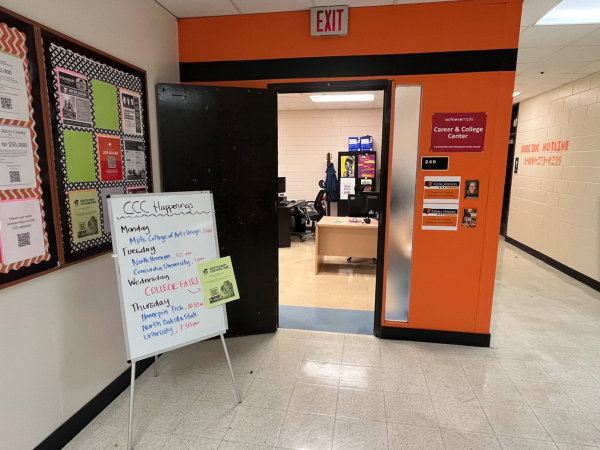Dropout students aren’t defined by stereotypes
May 30, 2014
“I was only at South for a semester, I had poor attendance, and I didn’t know how to do online gym … I thought it’d be better if I didn’t go to school anymore,” said Asialy Bracy-Gardella, who switched to South from St. Paul Academy (SPA) in her senior year, but decided to stop attending school during her first semester.
“Prior to…South I was really into pursuing knowledge,” Bracy-Gardella stated. “South was hard for me because that just wasn’t happening.” She explained that attending only one in-school class didn’t allow her to connect to her new school. She took other classes online or through PSEO.
Bracy-Gardella also quickly learned how difficult the process of credit transfers can make life at a new school.
“At that point my credits were funky because of my private to public school transfer,” This was when the concept of dropping out became appealing to her. “I realized I wouldn’t be taking classes for learning, but for credits.”
Bracy-Gardella’s story is not rare in Minneapolis Public Schools (MPS), where the average four-year graduation rate is 54% according to one of their February press releases.
South has a four-year graduation rate of 70%. The state average is 79.5%.
South counselor Marie Hassell attributes this disparity to higher poverty levels within inner-city schools. “We have larger amounts of students with higher needs than some of the suburban students,” she explained.
MPS 2013 student accounting data shows a correlation between graduation rates and socio-economic status. Southwest, which has the lowest free-and reduced-lunch rates at 36.9%, has the highest four-year graduation rate at 81.1%. MPS’s statistically poorest high school, North, has a 89.9% free-and-reduced-lunch rate, with only 36.8% of students graduating in four years.
Hassell has seen many students kept from earning their diploma by their lives outside of school, including family, financial, and mental health issues. “They just have so much going on that school is not their priority.”
Although difficult personal lives are the source of many students’ choice to drop out, for some, including Bracy-Gardella, it played no role in their decision. “I had relative privilege and access to resources,” she explained. “Everyone was super supportive and it wasn’t a big deal at all with my family
Bracy-Gardella, however, said that her in-school experience fueled her choice. “If I was excited about what was going on in the classroom then maybe I would’ve stayed. It felt worthless, like I was wasting my time.
“There are also a lot of kids who are very high achieving who don’t get their diploma,” Hassell said, agreeing that difficult personal lives aren’t always the reason for a missing diploma. “I’m always amazed. I think in general denial is a huge thing, kids, think I won’t notice if they don’t have PE…We have sheets and we keep track of every kid.”
“They [students] can graduate. You wish you had that ability to project that into their heads,” said Scott Wentworth, social studies teacher in the Partnership program.
Communication is key, he continued. “I can modify assignments if I know what’s happening. I can really work with students if I have a heads up.”
Bracy-Gardella affirmed that teachers impact a student’s decision to stay in school. “It’s about people being interested and engaged. Teaching curriculum in a way that makes students ask questions and making it applicable and interesting…can really help.”
For Hassell, communication between teachers, counselors and students is essential. “If kids are struggling or not coming to class we will only know what the attendance reports say. If the teachers are the first ones to let us know, we can keep an eye on them.”
Michael Berry, South’s truancy officer, is one of the first staff members to reach out to students with poor attendance. “My job is getting students engaged, attending school on a regular basis, and getting parents involved in their schooling.”
Berry will not be returning next year due to budget cuts, and he is concerned that students will not build strong relationships through the frequent staff changes. “If we continually employ staff and remove them… At some point students won’t want to connect at all.”
Lorraine Rhodes-Dix, a coordinator with the program We Want You Back (WWYB), said that the lack of community involvement within urban high schools has taken a toll on graduation rates.
WWYB helps dropout students reintegrate into the school system and receive their diploma. “We provide a caring adult who will work you step-by-step through the process of re-engaging,” said Rhodes-Dix.
According to Rhodes-Dix, destigmatization of post-high school options for students would positively affect their in-school engagement and increase graduation rates. “There were lots of programs that were career-oriented that were tossed away and marginalized. This made some kids think ‘I don’t want to learn if I’m not going to college.’”
In contrast, Bracy-Gardella said that dropping out of high school is a viable option for some students. “If you have support from your loved ones, you know what you’ll be doing with your time, and you’re truly confident with your decision, I think it’s fine to drop out.”
Now Bracy-Gardella has her GED and works 50 hours a week maintaining two different jobs with Sunrise Cyclery and Cycles for Change Bike Library. “I go on day trips, teach leadership, develop curriculum, and I have lots of paper work,” she laughed. She is looking forward to studying abroad in Argentina this fall.
Although Bracy-Gardella’s future seems clear-cut, that is not the case for most dropout students. According to the National Center on Secondary Education and Transition, students who do not graduate are much more likely to face unemployment, be incarcerated, and live in poverty compared to their graduating counterparts.
Rhodes-Dix has seen this from her experience and advises students to continue school. “Even though it feels tough, it’ll be tougher to keep going at a complete stop. Keep going; it’ll be better in the long run.”













Anon class of 2013 • Sep 23, 2014 at 8:22 pm
As a student who attended South for 4 years and didn’t graduate, most of what the above was very true. Although there were some specific staff who did try their best to help students like me, there just wasn’t enough being done.
I was a student who in my senior year ended up taking college courses such as AP Statistics and AP biology which were only two of the many college courses I took over my years at South. During my most difficult time at South, the school failed to meet my needs. The classrooms were so crowded that the teachers had no time during or after school to help individuals who needed more attention. Students who fell behind were expected to catch up and with very minimal help expected to know the curriculum.
I tell people all the time,but its sorta ironic how a student whos taken college courses all throughout their high school years who also exceeded the Minnesota standards could not graduate yet many students who stick with the bare minimum can.